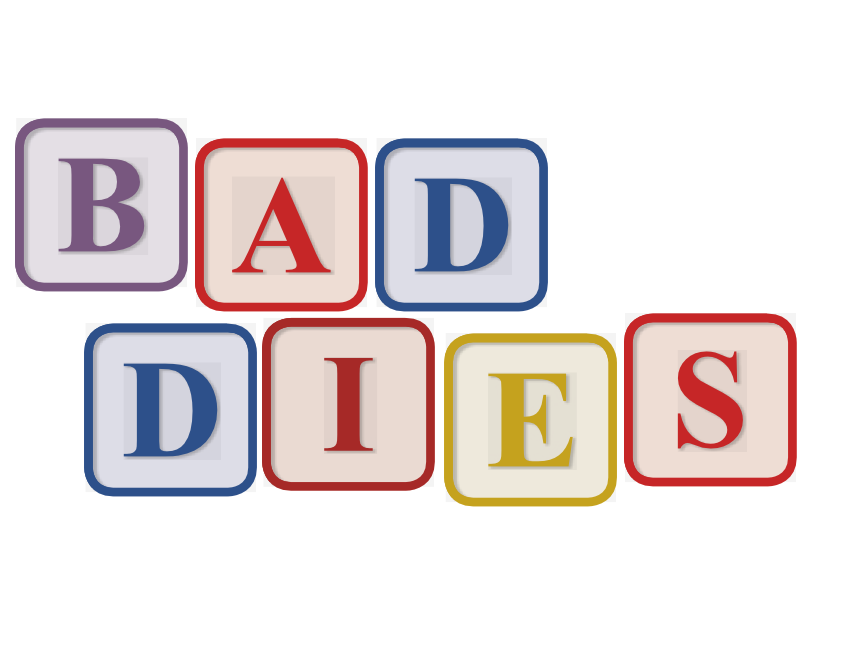Baddies
BonusParts from A to Z
B: BADDIES
For this entry into the BonusParts A to Z, I’m looking at the Baddies: types, ones I’ve enjoyed, and a few specific examples to hopefully tease some interest.

What’s a Baddie?
Generally speaking, baddies are the bad guys (or gals, or nonbinary individuals) who create conflict within my stories. Not every baddie is evil, though. Sure, some are nefarious villains, but others are simply rivals or foils. They are characters of their own, meaning they can have their own backstory, their own moral code, even their own objective within the story.
The Baddie’s purpose is to offer a point of contrast to the Hero. They are an obstacle to a goal. This can range from a charming challenger for a love interest’s affections to a sadistic crazy person out to destroy all of humanity. It all depends on the story.
She recalled the mysterious stranger in the grimy duster. “Is he a bad guy?”
“‘Bad’ is relative,” the man told her.
“Well, what’s he like?”
“Traitorous, sadistic, egocentric.” He sniffed. “Atrocious table manners.”
A Baddie’s badness level often relates to the overall stakes of the story. Your average Romance probably won’t have a baddie who is a serial killer. By the same token, you wouldn’t expect a Thriller to have a baddie whose primary role was as a romantic rival. I’m not saying you can’t have a serial killer who isn’t also a romantic rival, but the stakes need to add up appropriately for the primary genre you’re writing in.
My Baddies and Me
For a long time, I argued against the necessity of baddies. I thought non-corporeal sources of conflict – societal discrimination, accidents, familial responsibilities – could be enough to propel a story forward. The problem is that conflict against something intangible like social mores or a car accident can only go so far. Instead, these kinds of intangibles initiate reactions in characters that then manifest as more personalized conflicts: the potential lovebirds facing prejudice due to their racial differences. The hero battling his demons of self-doubt. The heroine trying to reconcile her relationships with her traditional family and her nouveau riche boyfriend.
It wasn’t until I looked back on these stories (Sixes and Sevens, Fearless, and 1 More Chance!, respectively) that I realized that a story’s baddies could reside within my goodies. Totally valid, and lots of fun to write. But not as much fun as an actual Baddie.

A Rundown of Recent Baddies
I’m going to highlight some examples of baddies in my novella, Number Seven and the Life Left Behind, which anyone can read if they so choose. [Purchase link; opens in a new tab.] The story’s main protagonist, Number Seven, encounters a few different types of antagonists throughout his adventure:
- Number Fourteen is an adversary to Seven. She does her job, but she does it with cruelty, and she’s got a pretty mean streak. She’s designed to be unlikable.
- Number Twelve is a counterpoint to Seven. He’s a jaded professional who doesn’t really care about anything anymore. I created him to show that Seven’s working world is full of a lot of different people, and not everyone who disagrees with him has been corrupted. Some of them are just tired.
- Number Nine is Seven’s rival, of sorts. She’s as good if not better an agent as he is, though she is portrayed as being more severe. She’s a foil to his endeavors. I wanted her to be a competent but frustrated woman fighting for respect in a predominantly man’s world. Seven doesn’t see her as an enemy except for the situation they’re in, and that’s what really makes her dangerous.
- Number Two is the story’s straight-up villain. He’s Seven’s opposite in nearly every way. He’s vindictive, malicious, manipulative, and pompous, a man who will allow or do anything for sake of the grand plan, no matter who it hurts or how.
Not only did these characters serve separate purposes, they also offered diverse perspectives on the world in which the hero lives. And they were all a sheer delight to write. They are still baddies, though, and do not take the place of the hero. I’m not saying antagonists can’t have their own stories or their own motivations; some of the best are those whose points of view we can understand. But your story’s baddie is not the same as your story’s hero. Otherwise, it would be a different story.
Do you like writing Baddies? What kinds of Baddies do you prefer to write or to read? Let me know in the comments!

I’ve always enjoyed the balancing act of “the Antagonist versus the Baddie”, since they don’t have to be the same thing. Like how you count Number Nine as not a Baddie per se, but an opposing force to Number Seven. She’s relatable, and the reader can see why she stands in Seven’s way, but there no malice really involved. It gives competition and drama to a story without needing the big goofy mustache to twirl.
From the last time I read ‘Fearless’: where does Amber’s dad fit in this thinking for you? I read him as a Baddie, but was that your direction?
Personally, I enjoy writing Baddies and antagonists very much. Maybe even more than the protagonists/heroes of my stories, because they don’t have to care about such silly things like morals or consequences. If I want to make a character irredeemable, detailing how they bombard the surface of a helpless world into glass is fun to describe. Or, in a personal vein, how taking someone down in a back alley with a clean shot was never personal, it was just a name attached to a stack of currency.
Looking forward to reading more of your Baddies!
Thanks, Chase!
Amber’s dad in Fearless is probably closest to a foil, like Sam is. They’re not evil or even bad, really. They simply present obstacles to the hero and heroine by their own points of view.
I did enjoy writing Number Two and Number Fourteen. And I’m having a lot of fun with the villains in my sci-fi adventure. Other writers say we have to create villains that are equally as engaging as our heroes, but I just can’t do it. I can write them as counterpoints or obstacles or sources of conflict, but I don’t think I could see myself writing a story centered around them. They just don’t gel as well with me.
I’ve always admired writers who can set aside their personal morals and dive deep into an antagonist’s patterns, though! Personally, I can never stay there for long. The closest I can get are anti-heroes.